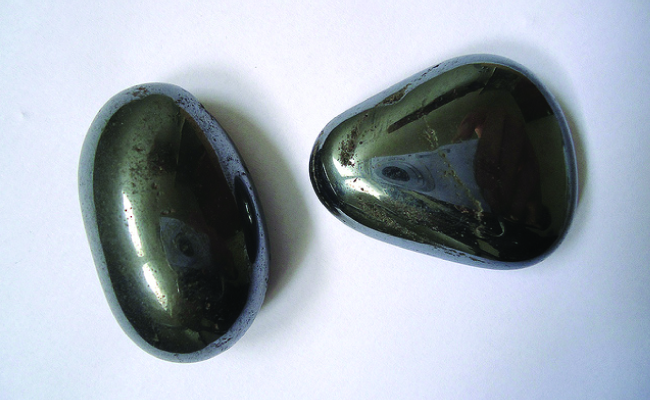Example 3.11: Determining a Compound’s Empirical Formula from the Masses of Its Elements
A sample of the black mineral hematite ( Figure 12), an oxide of iron found in many iron ores, contains 34.97 g of iron and 15.03 g of oxygen. What is the empirical formula of hematite? Figure 12: Hematite is an iron oxide that is used in jewelry. (credit: Mauro Cateb)
Figure 12: Hematite is an iron oxide that is used in jewelry. (credit: Mauro Cateb)
Solution
For this problem, we are given the mass in grams of each element.\(m_{\mathrm{\ce{Fe}}}\) \(= 34.97\ \mathrm{g}\)
\(m_{\mathrm{\ce{O}}}\) \(= 15.03\ \mathrm{g}\)
\(\mathrm{ratio}_{\mathrm{molar}}\) = ?
Begin by finding the chemical amount of each:
\(n_{\mathrm{\ce{Fe}}}\) \(= \dfrac{m_{\mathrm{\ce{Fe}}}}{M_{\mathrm{\ce{Fe}}}}\)
\(\ \ \ =\dfrac{34.97\ \mathrm{g}}{55.845\ \frac{\mathrm{g}}{\mathrm{mol}}}\)
\(\ \ \ =0.6262\ \mathrm{mol}\)
\(n_{\mathrm{\ce{O}}}\) \(= \dfrac{m_{\mathrm{\ce{O}}}}{M_{\mathrm{\ce{O}}}}\)
\(\ \ \ =\dfrac{15.03\ \mathrm{g}}{15.999\ \frac{\mathrm{g}}{\mathrm{mol}}}\)
\(\ \ \ =0.9394\ \mathrm{mol}\)
There is less iron than oxygen, so calculate the oxygen-to-iron molar ratio:
\(\mathrm{ratio}_{\mathrm{\ce{O:Fe}}}\) \(= \dfrac{n_{\mathrm{\ce{O}}}}{n_{\mathrm{\ce{Fe}}}}\)
\(\ \ \ =\dfrac{0.9394\ \mathrm{mol}}{0.6262\ \mathrm{mol}}\)
\(\ \ \ =1.500\)
The ratio is of iron to oxygen is 1 : 1.500, so the formula is
\(\ce{ FeO_{1.5}}\)
Finally, multiply all coefficients by two to get the smallest possible whole number subscripts while still maintaining the correct iron-to-oxygen ratio:
\(\ce{ Fe2O3}\) empirical formula
The empirical formula is \(\ce{Fe2O3}\).